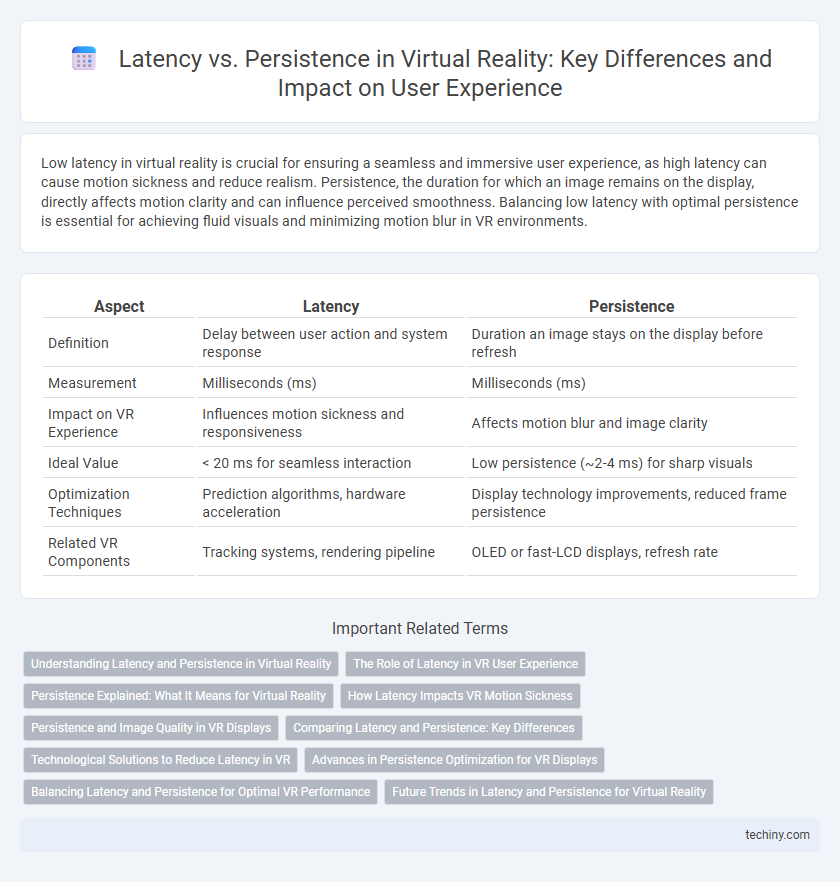Low latency in virtual reality is crucial for ensuring a seamless and immersive user experience, as high latency can cause motion sickness and reduce realism. Persistence, the duration for which an image remains on the display, directly affects motion clarity and can influence perceived smoothness. Balancing low latency with optimal persistence is essential for achieving fluid visuals and minimizing motion blur in VR environments.
Table of Comparison
| Aspect | Latency | Persistence |
|---|---|---|
| Definition | Delay between user action and system response | Duration an image stays on the display before refresh |
| Measurement | Milliseconds (ms) | Milliseconds (ms) |
| Impact on VR Experience | Influences motion sickness and responsiveness | Affects motion blur and image clarity |
| Ideal Value | < 20 ms for seamless interaction | Low persistence (~2-4 ms) for sharp visuals |
| Optimization Techniques | Prediction algorithms, hardware acceleration | Display technology improvements, reduced frame persistence |
| Related VR Components | Tracking systems, rendering pipeline | OLED or fast-LCD displays, refresh rate |
Understanding Latency and Persistence in Virtual Reality
Latency in virtual reality refers to the delay between a user's action and the corresponding visual update, critically affecting immersion and user comfort. Persistence describes how long a display pixel remains illuminated after being activated, impacting motion clarity and reducing image blur. Minimizing latency and optimizing persistence are essential for delivering smooth, realistic VR experiences and preventing motion sickness.
The Role of Latency in VR User Experience
Latency in virtual reality directly impacts motion-to-photon delay, influencing user immersion and comfort by minimizing motion sickness and visual disorientation. Lower latency ensures real-time responsiveness between user actions and VR system feedback, crucial for maintaining seamless interaction and presence within the virtual environment. High-performance VR devices target latency under 20 milliseconds to optimize user experience and reduce perceptible lag.
Persistence Explained: What It Means for Virtual Reality
Persistence refers to the duration a pixel remains illuminated on a VR display, directly impacting motion clarity and image stability. High persistence causes motion blur by keeping images visible for longer than necessary, while low persistence reduces blur but may introduce flicker if not properly managed. Optimizing persistence is crucial for immersive VR experiences, balancing smooth visuals with user comfort and minimizing motion sickness.
How Latency Impacts VR Motion Sickness
High latency in virtual reality systems significantly contributes to motion sickness by creating a mismatch between visual input and bodily sensations. When the delay between a user's head movement and the corresponding update in the virtual environment exceeds 20 milliseconds, users often experience disorientation and nausea. Reducing latency to below this threshold is critical for maintaining immersive, comfortable VR experiences and minimizing motion sickness symptoms.
Persistence and Image Quality in VR Displays
Persistence in VR displays directly affects image quality by determining how long each frame remains visible on the screen, reducing motion blur and enhancing visual clarity during head movements. Lower persistence minimizes the smearing of fast-moving images, resulting in sharper, more immersive visuals that improve user comfort and realism. Optimizing persistence settings balances brightness and image stability, making it a critical factor in high-performance VR experiences.
Comparing Latency and Persistence: Key Differences
Latency refers to the delay between a user's action and the corresponding visual update in a virtual reality environment, directly impacting the system's responsiveness and user immersion. Persistence measures how long a pixel remains illuminated before changing, affecting motion blur and image clarity during head movement. Lower latency enhances interaction speed, while optimal persistence minimizes visual artifacts, making both critical for a seamless VR experience.
Technological Solutions to Reduce Latency in VR
Low latency is crucial in virtual reality to minimize motion sickness and enhance user immersion, achieved through advanced technologies such as asynchronous timewarp and motion prediction algorithms. High-refresh-rate displays combined with optimized GPU pipelines significantly reduce latency by decreasing frame rendering times and delivering smoother visual updates. Hardware innovations like foveated rendering utilize eye-tracking to lower computational load, thereby accelerating responsiveness and improving overall VR performance.
Advances in Persistence Optimization for VR Displays
Advances in persistence optimization for VR displays have significantly reduced motion blur by controlling pixel illumination duration, resulting in sharper and more immersive visuals. Techniques like low-persistence OLED and variable persistence backplanes improve display responsiveness without introducing latency, enhancing user comfort and reducing motion sickness. These developments allow VR systems to maintain high frame rates while delivering clear, fluid image transitions critical for realistic virtual environments.
Balancing Latency and Persistence for Optimal VR Performance
Balancing latency and persistence is crucial for optimal VR performance, as low latency ensures real-time responsiveness while appropriate persistence reduces motion blur and visual artifacts. High latency can cause disorientation and motion sickness, whereas excessive persistence may introduce ghosting effects that degrade image clarity. Fine-tuning the trade-off between these factors enhances user immersion and comfort in virtual reality environments.
Future Trends in Latency and Persistence for Virtual Reality
Future trends in latency and persistence for virtual reality emphasize ultra-low latency systems under 1 millisecond to enhance motion-to-photon responsiveness, significantly reducing motion sickness and improving immersion. Emerging display technologies like microLEDs and advanced pixel driving methods aim to minimize persistence blur by enabling near-instant pixel switching times. Integration of AI-driven predictive tracking and edge computing will further optimize latency reduction and persistence control, delivering seamless, high-fidelity VR experiences.
Latency vs Persistence Infographic

 techiny.com
techiny.com